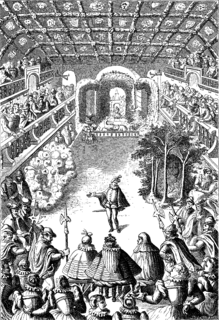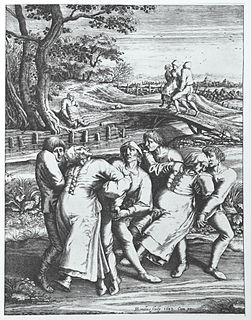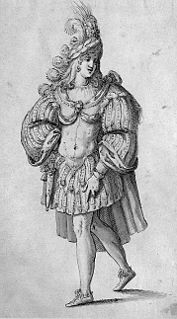 W
WRenaissance dances belong to the broad group of historical dances. During the Renaissance period, there was a distinction between country dances and court dances. Court dances required the dancers to be trained and were often for display and entertainment, whereas country dances could be attempted by anyone. At Court, the formal entertainment would often be followed by many hours of country dances which all present could join in. Dances described as country dances such as Chiarantana or Chiaranzana remained popular over a long period – over two centuries in the case of this dance. A Renaissance dance can be likened to a ball.
 W
WAn allemande is a Renaissance and Baroque dance, and one of the most popular instrumental dance styles in Baroque music, with notable examples by Couperin, Purcell, Bach and Handel. It is often the first movement of a Baroque suite of dances, paired with a subsequent courante, though it is sometimes preceded by an introduction or prelude.
 W
WAntonio Cornazzano was an Italian poet, writer, biographer, and dancing master.
 W
WThe Ballet Comique de la Reine was an elaborate court spectacle performed on October 15, 1581, during the reign of Henry III of France, in the large hall of the Hôtel de Bourbon, adjacent to the Louvre Palace in Paris. It is often referred to as the first ballet de cour.
 W
WThe basse danse, or "low dance", was a popular court dance in the 15th and early 16th centuries, especially at the Burgundian court. The word basse describes the nature of the dance, in which partners move quietly and gracefully in a slow gliding or walking motion without leaving the floor, while in livelier dances both feet left the floor in jumps or leaps. The basse danse was a precursor of the pavane as a dignified processional dance. The term may apply to the dance or the music alone.
 W
WBalthasar de Beaujoyeulx, originally Baldassare de Belgiojoso was an Italian violinist, composer, and choreographer.
 W
WBergamask, bergomask, bergamesca, or bergamasca, is a dance and associated melody and chord progression.
 W
WA branle, also bransle, brangle, brawl, brawle, brall(e), braul(e), brando, bran, or brantle, is a type of French dance popular from the early 16th century to the present, danced by couples in either a line or a circle. The term also refers to the music and the characteristic step of the dance.
 W
WCatherine de' Medici's patronage of the arts made a significant contribution to the French Renaissance. Catherine was inspired by the example of her father-in-law, King Francis I of France, who had hosted the leading artists of Europe at his court. As a young woman, she witnessed at first hand the artistic flowering stimulated by his patronage. As governor and regent of France, Catherine set out to imitate Francis's politics of magnificence. In an age of civil war and declining respect for the monarchy, she sought to bolster royal prestige through lavish cultural display.
 W
WDancing mania was a social phenomenon that occurred primarily in mainland Europe between the 14th and 17th centuries. It involved groups of people dancing erratically, sometimes thousands at a time. The mania affected men, women, and children who danced until they collapsed from exhaustion. One of the first major outbreaks was in Aachen, in the Holy Roman Empire, in 1374, and it quickly spread throughout Europe; one particularly notable outbreak occurred in Strasbourg in 1518 in Alsace, also in the Holy Roman Empire.
 W
WThe Dancing Master is a dancing manual containing the music and instructions for English country dances. It was first published in 1651 by John Playford.
 W
WDomenico da Piacenza, also known as Domenico da Ferrara, was an Italian Renaissance dancing master. He became a very popular teacher with his students – most notably Antonio Cornazzano and Guglielmo Ebreo da Pesaro – who both later became successful dance masters. At a time between 1452 and 1463 he received the Order of the Golden Spur.
 W
WThe galliard was a form of Renaissance dance and music popular all over Europe in the 16th century. It is mentioned in dance manuals from England, Portugal, France, Spain, Germany, and Italy.
 W
WThe jig is a form of lively folk dance in compound metre, as well as the accompanying dance tune. It first gained popularity in 16th-century Scotland and Northern England, and was quickly adopted on mainland Europe where it eventually became the final movement of the mature Baroque dance suite. Today it is most associated with Irish dance music, Scottish country dance and the Métis people in Canada. Jigs were originally in duple compound metre,, but have been adapted to a variety of time signatures, by which they are often classified into groups, including light jigs, slip jigs, single jigs, double jigs, and treble jigs.
 W
WThe masque was a form of festive courtly entertainment that flourished in 16th- and early 17th-century Europe, though it was developed earlier in Italy, in forms including the intermedio. A masque involved music and dancing, singing and acting, within an elaborate stage design, in which the architectural framing and costumes might be designed by a renowned architect, to present a deferential allegory flattering to the patron. Professional actors and musicians were hired for the speaking and singing parts. Often the masquers, who did not speak or sing, were courtiers: the English queen Anne of Denmark frequently danced with her ladies in masques between 1603 and 1611, and Henry VIII and Charles I of England performed in the masques at their courts. In the tradition of masque, Louis XIV of France danced in ballets at Versailles with music by Jean-Baptiste Lully.
 W
WMoresca (Italian), morisca (Spanish), mourisca (Portuguese) or moresque, mauresque (French), also known in French as the danse des bouffons, is a 15th/16th century pantomime dance in which the executants wore Moorish costumes. One such is the concluding music of Monteverdi's L'Orfeo. One of the best examples of the moresca can be seen in Franco Zeffirelli's 1968 production of Romeo and Juliet, which has a scene with moresca characters and lavish, florid portrayal of the dance in the Capulet home.
 W
WThe passepied is a French court dance. Originating as a kind of Breton branle, it was adapted to courtly use in the 16th century and is found frequently in 18th-century French opera and ballet, particularly in pastoral scenes, and latterly also in baroque instrumental suites of dances. In English the passepied has been spelled "paspy" as well as "paspie" or "paspe", phonetic approximations of the French pronunciation.
 W
WThe pavane is a slow processional dance common in Europe during the 16th century (Renaissance).
 W
WThe saltarello is a musical dance originally from Italy. The first mention of it is in Add MS 29987, a late-fourteenth- or early fifteenth-century manuscript of Tuscan origin, now in the British Library. It was usually played in a fast triple meter and is named for its peculiar leaping step, after the Italian verb saltare. This characteristic is also the basis of the German name Hoppertanz or Hupfertanz ; other names include the French pas de Brabant and the Spanish alta or alta danza.
 W
WThe volta is an anglicised name for a dance for couples that was popular during the later Renaissance period. This dance was associated with the galliard and done to the same kind of music. Its main figure consisted of a turn and lift in a sort of closed position, which could be done either to the right or to the left. It is also called La volta, Volta, Volte. Spelling variants include la volta and levolto; its name is la volte in French and la volta in Italian. Considered at first to be risque and controversial, La volta became a respectable, but never completely dignified, dance after Queen Elizabeth I of England danced it with the Earl of Leicester.